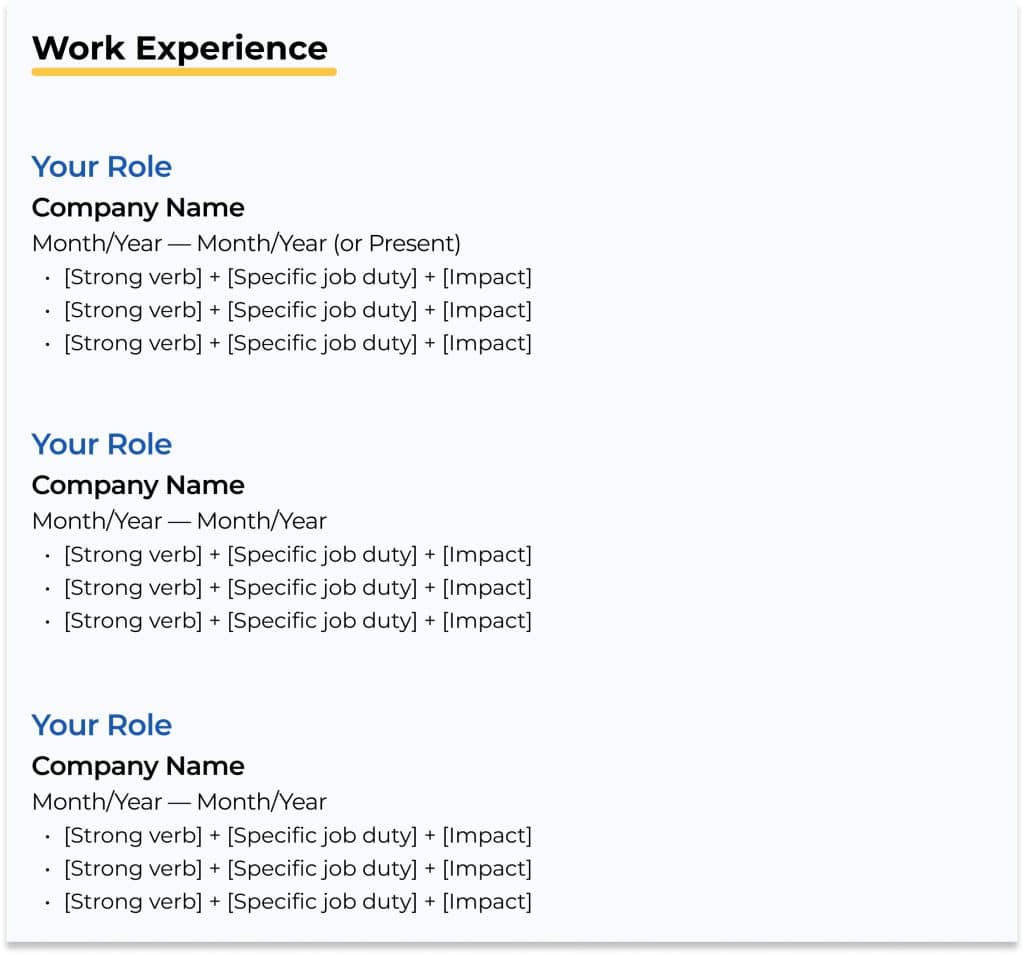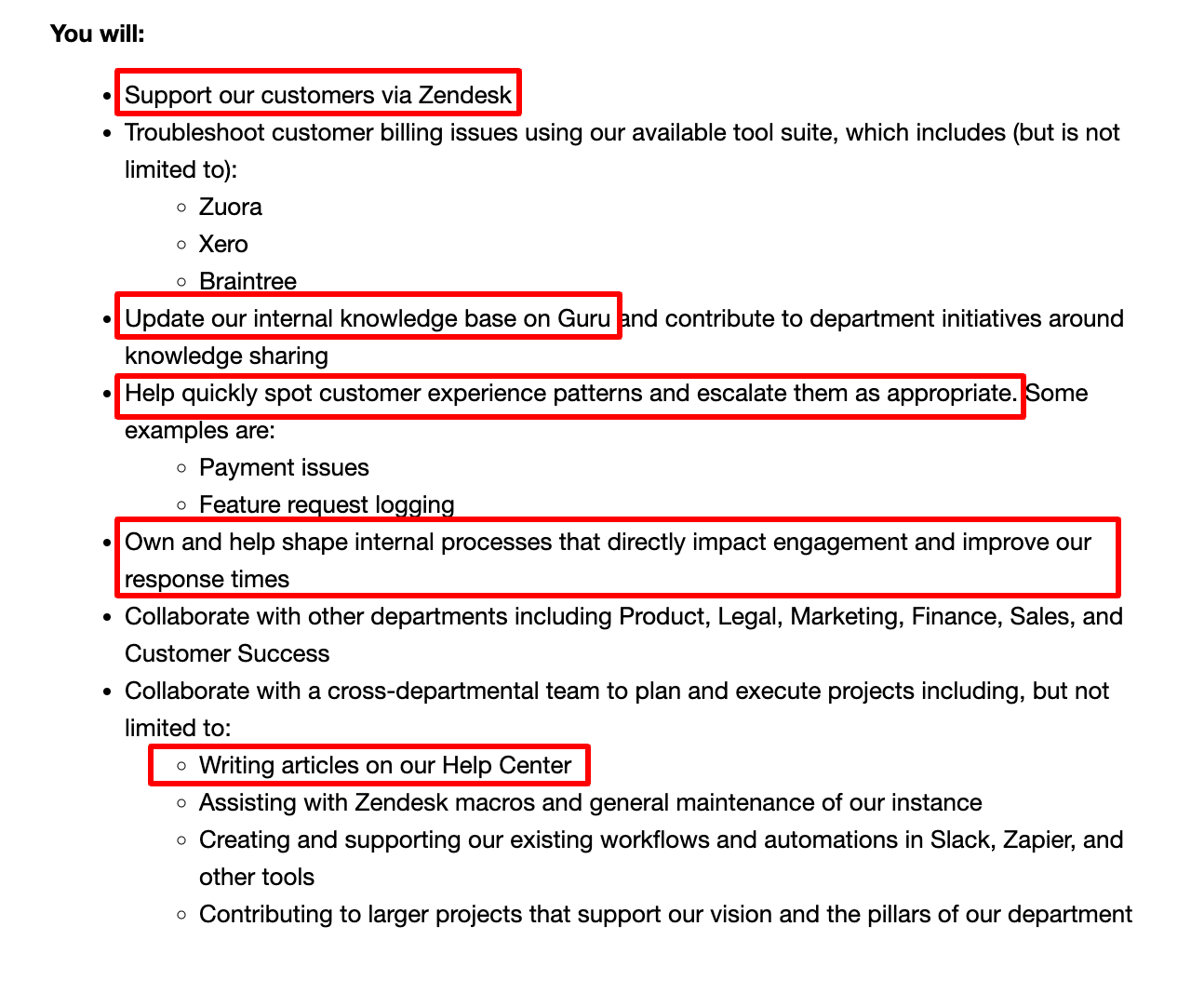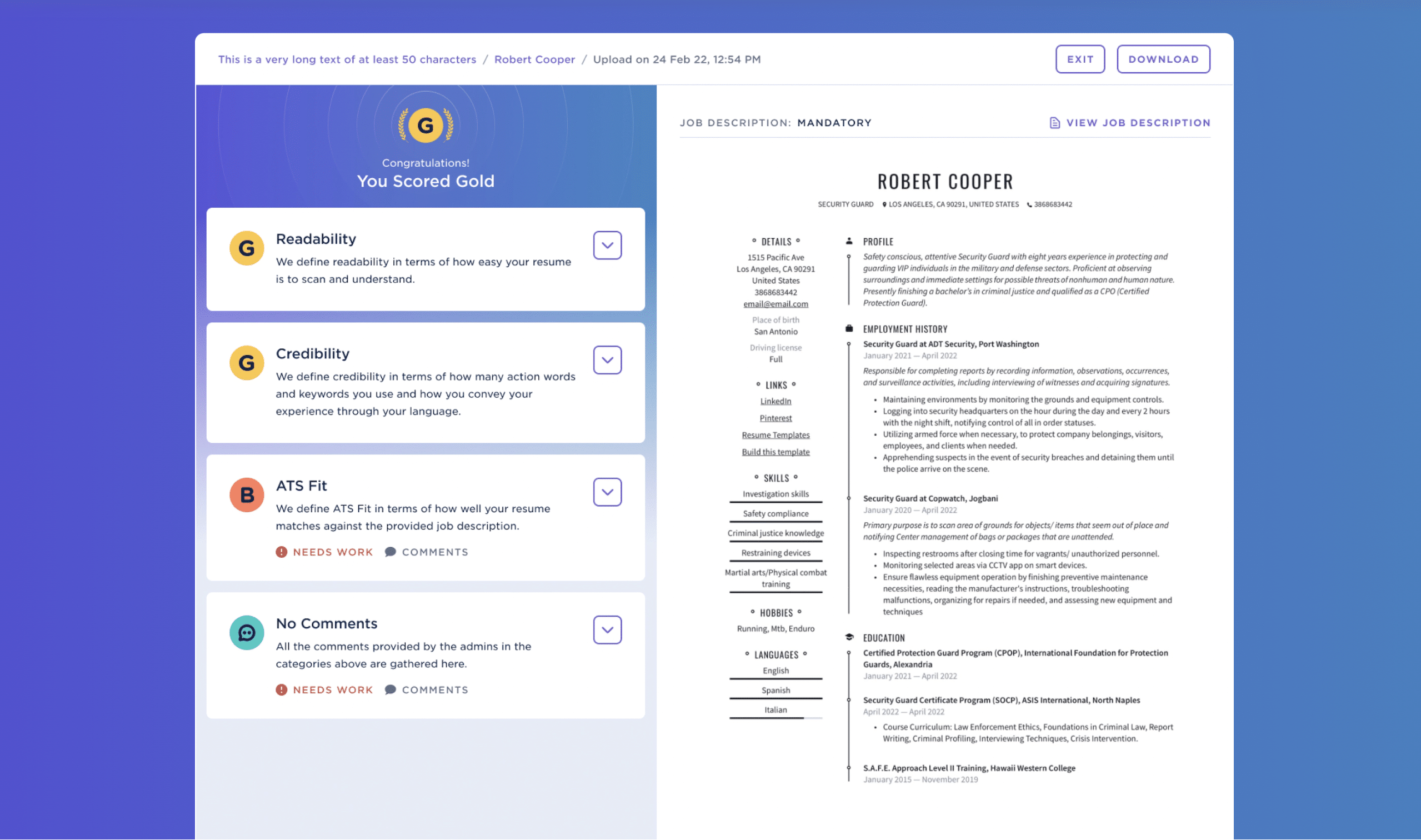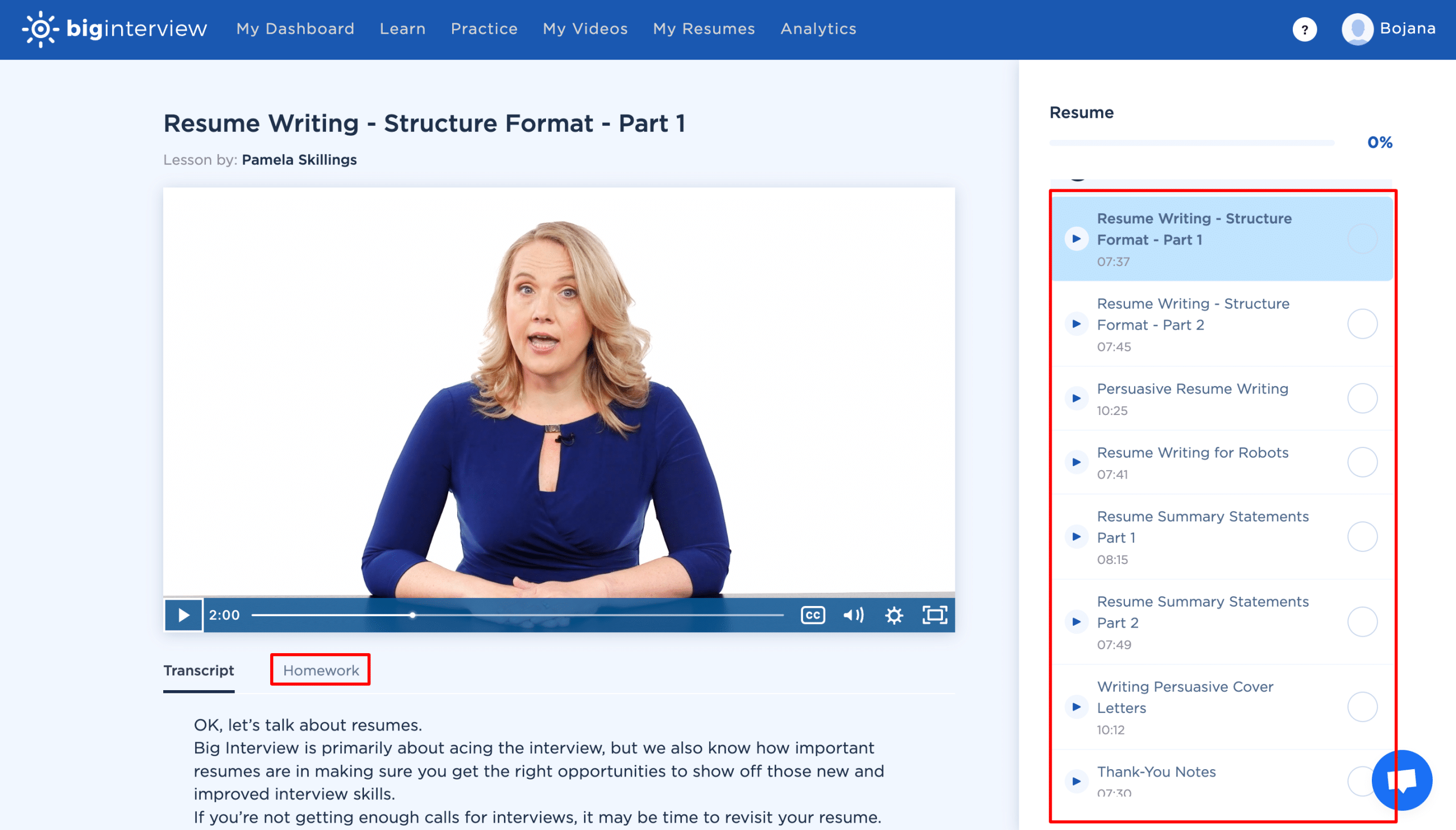
Not sure how to showcase your work experience on a resume? Here's everything you need to know about how to best write this tricky resume section.

Your work experience is the resume section hiring managers look at first. And if they’re busy, it’s often the only part they review. To get the interview, you need to pay extra attention to your resume work history section. In practice, this means you should spend roughly 80% of the total time spent on your resume on the work experience section. As with other resume sections, there are some simple rules to follow. In this guide, we’ll unpack them for you and help you create a resume that stands out every single time.
Here’s what you’ll master today:

Make sure your work experience section is clearly visible and has its own heading. You can name this section “Work Experience”, “Experience” or “Employment History”.
It’s best to place the experience section right under your resume summary or a resume objective. However, if you’re fresh out of college and have little or no work experience, you can fit the work history under your education section.
You typically list your work experience in reverse chronological order — put your current or most recent gig at the top, followed by the previous one, then the one before that, and so on.
This is effective because it gives the hiring team the most relevant information instantly. If you’re a UX designer looking for a new opportunity, the hiring manager will want to know about your most recent accomplishments to see how you progressed, where your expertise lies, and how your latest experience can translate into success in your new role.
Do you need to put all your past experience on a resume? By no means. Professional resume writers and career coaches advise that you include up to 15 years of relevant work experience. Including every single job you’ve done (like that pizza delivery summer gig when you were 16) can actually work against you.
Remember, this is just a general rule that can be broken in certain situations.
For instance, if you’re looking for a job in tech, where skills, frameworks, and tech stacks change often, your experience from 13 years ago may not be truly relevant today.
Also, if you’ve had a major career change, e.g. switched from teaching to copywriting 10 years ago, you could omit your teaching roles. However, if working in that position gave you relevant skills and experience that you still consider useful and valuable (e.g. clear communication, time management, or presentations), you can definitely include it in your resume.
Read on if you’re changing careers, switching from the military, or are freshly graduated (we’ll cover those scenarios in a bit).
This is a big one. It’s crucial to format your entries properly so that the information is easy to spot and read. Also, consistency is hugely important. Maintain the same order of information in each entry for a polished, organized, and harmonious look.
Here’s how you can order the items in a single work experience entry:
Instead of writing a paragraph or description explaining your role in detail, make sure to use a bulleted list (it’s way clearer, better organized, and memorable).
Next, it’s always wise to focus on your most important accomplishments and achievements, rather than simply listing your everyday responsibilities. After all, the point of this section is to gently persuade the hiring team that you’re equipped to do the job and that you have an excellent track record.
In other words, this is where it pays to take a moment to think back to your biggest career wins and corroborate that with some data (more about this later).
Finally, make sure to limit the number of bullets as you go back in time. While it’s perfectly fine to have 5–8 points for your latest job, 3–4 will be enough for older entries.

Now let’s put theory into practice and look at two great examples of work history on a resume that follow the steps we discussed above.
Vice President of Marketing
Vue
03/2017 – Present
Now let’s zoom in on your work experience section even closer and help you take those bullet points from average to outstanding. To sell yourself on your resume, just follow these simple tips.
This is precisely where most candidates get stuck. A lot of you are probably thinking: yes, I’ve heard this piece of advice many times. But I don’t have any stellar achievements. I just do my job well.
Precisely. That’s enough to be sure you do have achievements. You might not even know it. And the best way to showcase those is by hard numbers.
Again, don’t freak out. You don’t have to be in the data and numbers game to be able to come up with quantifiable results and statistics. There are simple strategies to present tangible results to back up your accomplishments.
And just so you realize how miserably bad people are at showcasing their accomplishments —
Here’s a real-life story that a resume-writing consultant friend told me.
He was hired to revamp a spacecraft engineer’s resume (btw, how cool is that!). When she walked him through her resume and explained what each item meant, one caught his attention — ”Optimized and automated the procurement and invoicing flow.” Optimizing and automating? That always means something cool.
She eventually explained how she made a highly complex process fully automatic, and in doing so, saved around 18 work hours a month for 7 people each. These people were paid an average of $200/hr. That’s $1.3 million a year saved for the company. And that was not on her resume.
Why am I telling you this?
Because this is proof that you’re not alone in being horrible at framing duties as achievements. Apparently, even the most extraordinary candidates are. Bottom line: you will most definitely stand out if you know how to do it!
So here are a few tips on how to really stand out from the crowd:
Mention the scale, e.g. how many people you managed, or the size of the budgets you handled
Mention the frequency, e.g. how many tasks you performed within a time frame
Mention specific results, e.g. money and time saved
Pro tip: Record your accomplishments as they happen. This is how I do it. Every time something cool happens (e.g. 89% of email subscribers click on the CTA button in an email and read my article or 5 product demos were booked on a blog page that I wrote), I take a note in a Google document. Even if I’m not actively looking for a job. (Or not even thinking about it.) In time, you’ll have a killer list of accomplishments to add to your resume, cutting your writing time in half. Otherwise, you’ll either forget the details or spend hours digging through your old projects to find the right info.
If you take a closer look at all the examples we listed in this guide so far, you’ll notice a few common themes — none of the bullets start with “I” and they sound super descriptive although we used zero adjectives.
The secret lies in action verbs, the powerful verbs that are used at the beginning of each bullet to draw the reader in and show your impact.
Take a look at these examples again:
Combined with numbers and specific results, these verbs show the recruiting team exactly how you accomplished things and attained goals at work.
There are extensive lists of power/action verbs you can find on the web, but here’s a short list of our favorite ones to get you started.
Top 50 action verbs to use in your resume work experience section:
Expert tip: Vary your power verbs to avoid repetition. Keep your bullet points as short as possible and avoid the use of pronouns, articles, and adjectives.
Here’s an example of a bland work experience section turned amazing and catchy by applying the 3 tips above.
Why we think it sucks:
Let’s dissect this Frankenstein.
Now let’s see how you can transform this meh work history section into an unforgettable one by using action verbs and quantifiers.
Why we love this version:
First, it’s super specific and it tells us exactly what this Content Marketing Manager did. Next, they listed the results of their efforts in a consistent and persuasive way. Finally, a nice mix of power verbs (designed, oversaw, increased, and conducted) leaves the reader with the impression that this person knows what they’re doing.
We’ve been saying this forever and we’ll say it again: don’t expect to have a single resume that can win you endless jobs. Heck. Don’t expect a generic, all-purpose resume to land you more than 1 interview out of 50 applications.
That’s not how the pros do it.
Instead, you’ll need multiple versions that you’ll then further customize by tailoring your work experience section to the exact position you’re targeting.
The easiest way to do this is to peruse the job description, identify which skills and requirements matter to the employer and then have your resume prove that you possess those very skills.
Here’s how it works in practice.
Let’s say a MarTech company is looking for someone to join the Billing Customer Support Team.
Here is a sample job ad and some of the requirements and duties listed in the description:

After carefully reading the job description details, this candidate found 5 points they have previously excelled in. Next, they’ll use them as guidelines to tailor their work experience resume section to match the requirements 100%.
Customer Support Engineer
Omnis
Why we like this answer:
The candidate relied on the information from the job ad to highlight their accomplishments in a clear and convincing way. They showed their familiarity with Zendesk, their dedication to keeping the internal company wiki updated, and proved that they are independent and proficient enough to write technical documentation. Finally, they illustrated most of their efforts with relevant metrics and KPIs and used power verbs to convey authority and skill.
This may make perfect sense to someone who’s had 10+ years of experience and few job gaps. But what if you’re applying for a job outside your industry or aren’t sure whether to include your volunteer experience? Here are all your questions answered.
If you’ve held multiple positions in the same company or if you’d like to highlight your growth and change in roles, you can approach this in two different ways.
1) List them as a single entry if similar and if the career path is clear. Start with the company name, dates worked, and then list your positions together with the from-to period when you held them. Like this:
Acme Technologies Inc.
03/2017 – Present
Content Marketing Manager (01/2021 – Present)
(a bullet-pointed list of accomplishments)
Content Writer (03/2017 – 01/2021)
(note the promotion, followed by a bulleted list of responsibilities and achievements)
2) List them as two separate entries if you made a bigger shift or changed departments (e.g. started in a call center, then switched to Business Development).
A note of caution: When using stacked entries (1), there’s a chance that the ATS software won’t recognize your promotion as such, and may list your skills and experience under the earlier position. To ensure your resume will be well-parsed by the ATS and look good, it’s safer to stick to the format shown in (2) and list your promotions as two separate entries.
Absolutely include your freelance work in your employment history, as it shows your versatility, skill set, and soft skills like client management, negotiation, and independence. Here’s an example of how a writer and illustrator listed their freelancing experience.
Content Writing Consultant (alternatively, you can use Contractor)
Freelance
If you can supply at least 5 years of paid work experience, you can skip your volunteering experience altogether or add them to other resume sections.
If your employment history is short or if you’re just starting your job search after being a stay-at-home parent or a student, then definitely include the volunteering gigs in your main work history section. After all, recruiters love seeing this type of experience — it tells a lot about who you are as a person, what you’re passionate about, and that you’re not entirely motivated by money.
When adding your part-time jobs to your resume work history, treat it like any other entry. However, make sure to add that you worked part-time. A simple note next to your position works just fine. Like this:
Online Marketing Specialist (part-time)
Forwa
You can include your internship just as you would with any other work experience, no matter if it was paid or not. Add your official role, the company name, and then provide a bulleted list of your responsibilities and accomplishments. Here’s how one candidate did it:
Front End Developer InternI’ll start with a general note here: people freak out about their employment gaps way more than they should. Yes, employment gaps on your resume can be considered red flags, but not by default.
As a matter of fact, a recent study published in the American Economic Review reveals that “long-term unemployment spells in the past do not matter for employers’ hiring decisions.” The study also found that all subsequent experiences canceled out the gaps in employment, as well as that employers didn’t treat short-term and long-term unemployment much differently.
So no reason to panic, okay?
You’d normally have the chance to explain the gaps in your employment in an interview. To get there, it’s wise to address them in your resume work experience section and provide a bit of information and context.
This is especially valid if the gaps are bigger and happened for a good reason like getting a degree, being a full-time parent or caregiver, or for medical reasons.
And here’s how you can integrate that smartly into your resume employment history.
Full-time ParentHere you’ll find some of the best resume experience examples for the most common professions.
Find out how to write a next-level resume work experience section for 100+ other professions in this free resume library.
Need a bit more guidance?
You can hop over to Big Interview’s Resume Builder, where you’ll get to enter your information section by section (basic info and contact details, summary, work experience, education, certifications, skills), choose the design and then have the tool create a resume for you. Here’s what you’ll find inside:

This is super useful because you can easily create many iterations (for different job ads) and save a bunch of time in the process.
Once that’s done, you can also use ResumeAI, a new feature that assesses your resume for various criteria hiring teams use in real life – how easy it is on the eye, how you used action words to convey experience and skills, and whether it’s ATS-friendly Basically, you’ll get a rating based on how effective you were in showcasing your skills and experience.

And if you need a bit more support, we created a short course on resume writing, designed and led by our own co-founder, Pamela Skillings (aka *the resume and job interview guru*). In this curriculum, you get 8 video lessons with Pam (with a transcript), after which you’ll be 100% sure to crush that resume.

TL; DR? Here’s the essence of a killer resume work experience section that you can copy in no time.
List 10–15 years of experience, depending on your individual circumstances. The key thing here is to include only relevant work experience, so if you’ve been in the job market for 10 years, but only 6 are relevant to the job you’re applying for, focus on those 6 years. You can still list the previous experience, but there’s no need to go into great detail.
A common guideline is to have 3–8 bullet points per entry. This way you can give plenty of relevant information about your achievements and responsibilities without overwhelming the reader with excessive detail. You can use 5–8 for your most recent and penultimate positions. As you work your way backwards, 3 bullet points is usually enough. Remember to aim for quality over quantity — if you can fit your best accomplishments into 3 bullet points, there’s no need to write 2 additional weak ones. Make sure to refer to your “strongest” qualities in the first 2 bullets.
Here are some examples of work experience that should not be included in your resume: irrelevant experience, experience from over 15 years ago, high school jobs, or volunteer work. However, this all depends on where you are in the career journey. For example, for first-time job seekers, school jobs, part-time jobs, and volunteer experience will matter.
If you have no or little formal work experience, include other types of experience and focus on your qualifications and results. Some ideas to consider: internships, volunteer work, academic projects, freelance or contract work, leadership roles in student associations or sport clubs, and community work. Don’t worry about your title or if it was a formal experience. Instead, focus on the relevant skills and tangible results you accomplished in these roles.
You can include it if you have little to no relevant professional experience. Otherwise, you can put it in a separate resume section or omit it if your resume is already full.
If there’s a significant gap in your resume, address it proactively in the document and don’t wait for it to come up at the interview (imagine you miss out on one because of that gap!). This way, your potential employers will know you have nothing to hide. Briefly explain the reasons for the gap, keep your language positive, and mention if you did any coursework or upskilling during that time. If you took a sabbatical to travel, take care of a family, or get degrees to prepare for a career change, say it proudly.
A general rule is to remove a job from your resume if it’s no longer relevant to the position you’re applying for. For example, if you’re applying for a marketing role, already had 4 marketing roles, but had initially worked as a history teacher for 1 year, it’s safe to assume your history teacher experience can be taken off. The point is to not overwhelm the resume with unrelated experience. You can also remove some short-term jobs or jobs you had a long time ago, especially if your resume is already getting longer than 2 pages.
That depends on several factors. If this was a recent position you held for a long time, you should include it. Otherwise, there would be a big employment gap that you’d still have to address (and it may come up anyway during a background check). If you can come up with a tactful, honest explanation behind the termination, and especially if you’ve gained new relevant skills in the meantime, don’t hesitate to include that position. On the other hand, if the job was a long time ago or if it’s unrelated to the position you’re currently applying for, feel free to omit it.